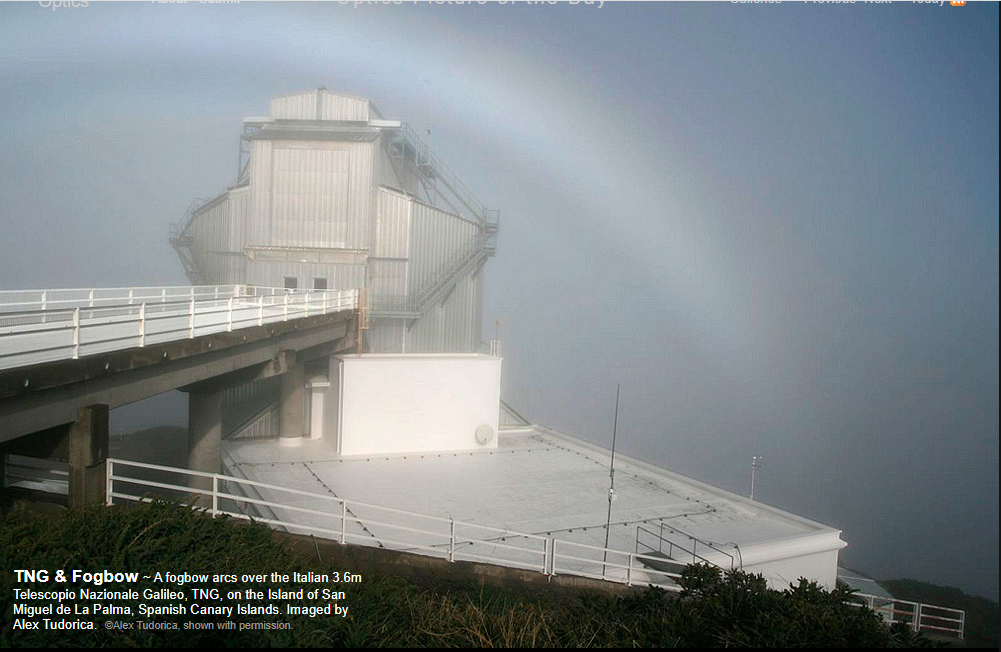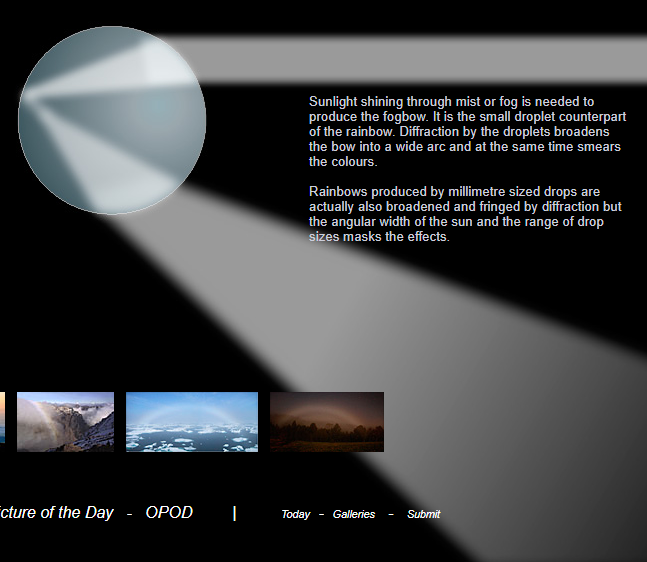TNG & Fogbow
TNG & Fogbow: A Spectacular Atmospheric Phenomenon
Have you ever seen a fogbow? This ethereal optical phenomenon is a captivating sight that occurs when sunlight shines through mist or fog. Similar to a rainbow, a fogbow is formed by the diffraction of light by tiny droplets in the air. In this article, we will delve into the mesmerizing world of fogbows and explore a stunning image captured over the Italian 3.6m Telescopio Nazionale Galileo (TNG) on the Island of San Miguel de La Palma, Spanish Canary Islands.
The Enchanting Island of La Palma
La Palma, known for its exceptional astronomical conditions, is home to several renowned observatories. Its location provides astronomers with excellent "seeing," which refers to the atmospheric conditions that affect the clarity and stability of celestial observations. However, in the image of the fogbow over TNG, the favorable seeing conditions are not immediately apparent due to the presence of mist or fog.
Unveiling the TNG Telescope
The Telescopio Nazionale Galileo (TNG) is a powerful instrument utilized for a wide range of astronomical research, from studying asteroids to unraveling the secrets of distant galaxies. Equipped with an altazimuth mounting, the TNG employs active optics technology to compensate for deformations in its thin primary mirror. By using an off-axis star, any distortions can be corrected, ensuring precise observations. This innovative system also adjusts the positions of the Nasmyth secondary and tertiary mirrors, further enhancing the telescope's performance.
The Birth of a Fogbow
To witness the enchanting spectacle of a fogbow, sunlight must pass through a mist or fog. The droplets suspended in the air act as tiny prisms that refract and diffract light. Similar to rainbows, fogbows display an array of colors. However, there are distinct differences between the two phenomena.
A Glimpse into the Science of Fogbows
While rainbows are formed by raindrops, fogbows are created by much smaller droplets. The diffraction of light by these minuscule droplets causes the fogbow's arc to broaden and blur, resulting in a wider and less defined shape compared to rainbows. Additionally, the colors of a fogbow are often less vibrant due to the diffraction process. The dispersion of light is more pronounced in rainbows produced by larger raindrops, masking the effects of diffraction.
A Captivating Image
The captivating image of a fogbow gracefully arching over the TNG telescope showcases the ethereal beauty of this atmospheric phenomenon. The photographer, Alex Tudorica, skillfully captured the moment, allowing us to marvel at the interplay between science and nature. The mist or fog surrounding the telescope adds an element of mystique, highlighting the contrast between the cutting-edge technology of the TNG and the timeless beauty of the natural world.
Conclusion
Fogbows are truly captivating optical phenomena that add a touch of magic to our everyday surroundings. As we gaze at the image of a fogbow over the TNG telescope, we are reminded of the intricate relationship between science and nature. The study of atmospheric optics allows us to unravel the mysteries of these enchanting spectacles, while simultaneously appreciating the awe-inspiring beauty they bring to our world. So, keep your eyes open for fogbows and other celestial wonders, as they remind us of the extraordinary wonders that exist both above and below the Earth's surface.

TNG & Fogbow ~ A fogbow arcs over the Italian 3.6m Telescopio Nazionale Galileo, TNG, on the Island of San Miguel de La Palma, Spanish Canary Islands. Imaged by Alex Tudorica. ©Alex Tudorica, shown with permission.
The island of La Palma is home to several major observatories thanks to its good seeing. The latter is not too evident in this image.
TNG is used for research ranging from asteroid studies to galaxies. It has an altazimuth mounting. Active optics using an off-axis star compensate for deformations of the thin primary mirror and correct the positions of the Nasmyth secondary and tertiary mirrors.
Sunlight shining through mist or fog is needed to produce the fogbow. It is the small droplet counterpart of the rainbow. Diffraction by the droplets broadens the bow into a wide arc and at the same time smears the colours.
Rainbows produced by millimetre sized drops are actually also broadened and fringed by diffraction but the angular width of the sun and the range of drop sizes masks the effects.

Note: this article has been automatically converted from the old site and may not appear as intended. You can find the original article here.
Reference Atmospheric Optics
If you use any of the definitions, information, or data presented on Atmospheric Optics, please copy the link or reference below to properly credit us as the reference source. Thank you!
-
<a href="https://atoptics.co.uk/blog/tng-fogbow/">TNG & Fogbow</a>
-
"TNG & Fogbow". Atmospheric Optics. Accessed on November 26, 2024. https://atoptics.co.uk/blog/tng-fogbow/.
-
"TNG & Fogbow". Atmospheric Optics, https://atoptics.co.uk/blog/tng-fogbow/. Accessed 26 November, 2024
-
TNG & Fogbow. Atmospheric Optics. Retrieved from https://atoptics.co.uk/blog/tng-fogbow/.